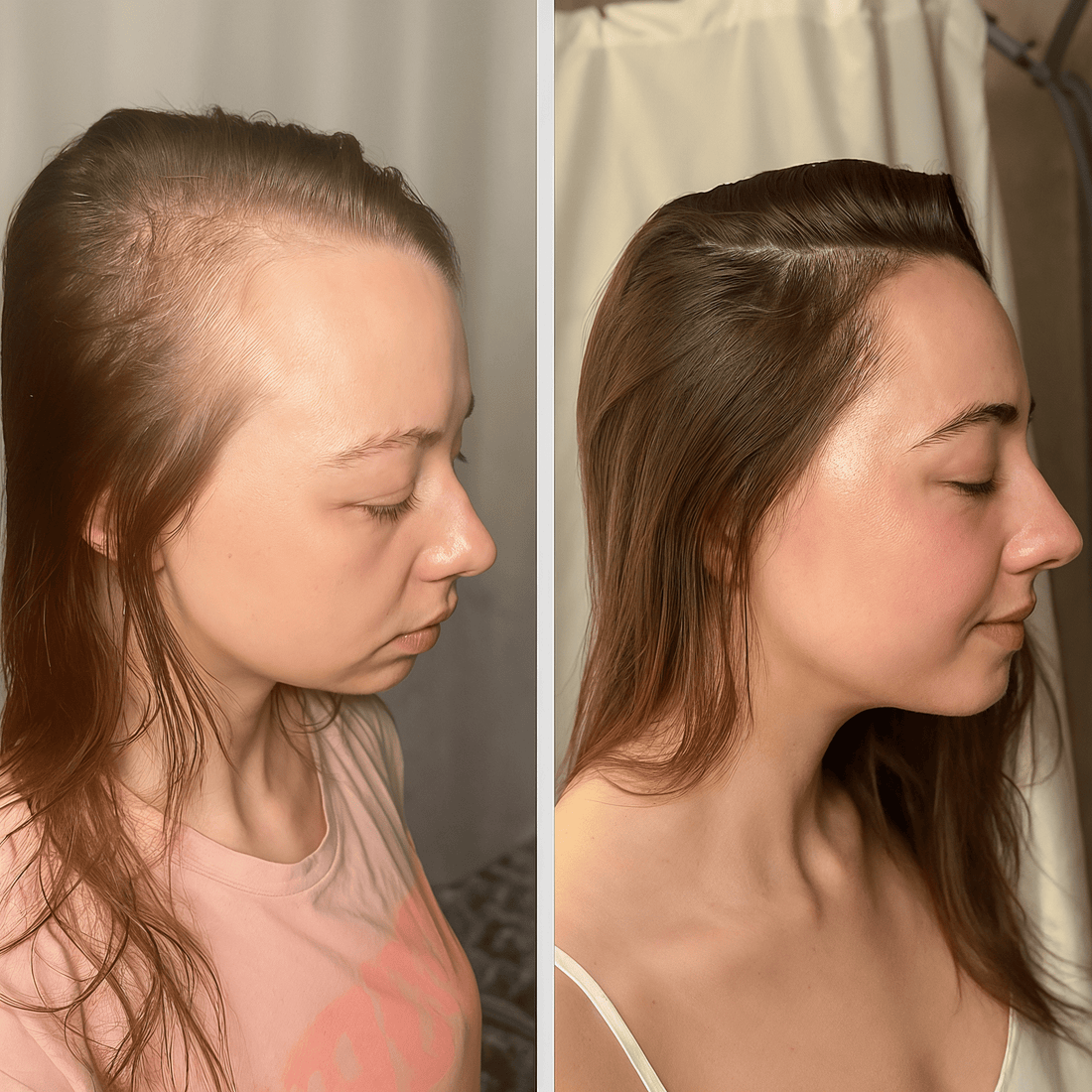Thinking about a hair transplant for women? You're entering territory that's far more complex than the male version. Female hair loss patterns, donor area limitations, and healing considerations make transplants for women a completely different ballgame—one that many surgeons don't fully understand.
While transplants can help some women, they're not the miracle solution the beauty industry wants you to believe. Most women face unique challenges that make surgery risky, expensive, and often disappointing. Before you commit to a procedure that could cost $30,000+ and take years to show results, let's explore what actually works for female hair restoration—and why many women are choosing advanced non-surgical alternatives instead.
How Hair Transplants Work Differently for Women
Hair transplant for women follows the same basic principle as men's procedures—moving hair from areas of density to thinning zones—but female hair loss patterns create unique challenges that many clinics overlook.
Female Hair Loss Patterns:
- Diffuse thinning: Overall density loss rather than distinct bald patches
- Ludwig pattern: Crown widening with preserved hairline
- Christmas tree pattern: Gradual thinning from crown forward
- Androgenetic pattern: Temple recession with crown thinning
- Scarring alopecias: Autoimmune conditions affecting follicles
Why Women's Transplants Are More Challenging:
- Limited donor areas: Women often have thinning throughout the scalp
- Unpredictable hair loss: Hormonal changes can affect donor stability
- Higher density expectations: Women need fuller coverage than men typically require
- Styling limitations: Women's hairstyles expose more scalp area
- Ongoing hormonal factors: Pregnancy, menopause, PCOS continue affecting hair
Common Techniques for Women:
- FUE (Follicular Unit Extraction): Individual follicle removal, preferred for women
- FUT (Strip method): Rarely used due to scarring concerns
- Body hair transplant: Using leg or arm hair when scalp donor is limited
- Eyebrow transplant: Specialized procedure for brow restoration
Critical insight: Many women aren't good candidates for transplants because they lack sufficient donor hair or have ongoing hormonal hair loss that continues after surgery.
Who Is (and Isn't) a Good Candidate
The harsh reality: most women experiencing hair loss are NOT ideal candidates for hair transplant surgery. Success requires very specific conditions that many women don't meet.
Good Candidates Are Rare:
- Stable donor area: Dense, healthy hair at back and sides
- Pattern baldness only: No autoimmune or hormonal hair loss
- Localized thinning: Specific areas rather than diffuse loss
- Realistic expectations: Understanding limitations of redistribution
- Post-menopausal: Hormonal fluctuations have stabilized
- Good healing history: No keloid scarring or healing issues
Poor Candidates (Most Women):
- Diffuse hair loss: Thinning throughout entire scalp
- Active hormonal changes: Pregnancy, perimenopause, PCOS
- Autoimmune conditions: Alopecia areata, lupus, thyroid disorders
- Scarring alopecia: Follicles permanently damaged
- Unrealistic expectations: Expecting full density restoration
- Young women: Hair loss pattern not yet established
The "Donor Depletion" Problem:
Women's hair loss often affects the entire scalp, including traditional "donor" areas. This means there may not be enough healthy hair to redistribute—a critical limitation many surgeons discover too late.
Hormonal Considerations:
- Pregnancy effects: Can cause donor hair to shed post-surgery
- Menopause changes: Continuing loss may require multiple procedures
- PCOS complications: Ongoing hormonal imbalance affects results
- Thyroid disorders: Unstable conditions compromise healing and growth
Smart surgeons require hormonal stability and comprehensive testing before considering women for transplantation.
Real Costs and Complications for Women
Hair transplant costs for women are typically higher than men's procedures due to complexity, higher graft requirements, and increased revision rates:
Initial Procedure Costs:
- FUE for women: $6-$20 per graft ($12,000-$40,000 total)
- Eyebrow transplant: $3,000-$8,000
- Revision procedures: $8,000-$25,000 (common in women)
- Body hair transplant: $10,000-$30,000 (when scalp donor insufficient)
Women-Specific Additional Costs:
- Hormonal testing: $500-$2,000 pre-procedure
- Dermatology consultation: $300-$800 to rule out autoimmune conditions
- Hair integration systems: $2,000-$8,000 while waiting for growth
- Specialized aftercare: Women often need more intensive post-op support
- Camouflage products: Concealers and fibers during healing
Hidden Complications:
- Shock loss: Existing hair around transplant area falls out (common in women)
- Poor growth rates: Women often see lower survival rates than men
- Unnatural appearance: Difficulty achieving feminine hairline and density
- Ongoing loss: Non-transplanted hair continues thinning
- Scarring issues: Women more prone to visible scarring
Lifetime Investment Reality:
- Single procedure (rare success): $15,000-$40,000
- Multiple procedures (common): $30,000-$80,000+
- Maintenance and touch-ups: $5,000-$15,000 annually
- Total 10-year cost: $50,000-$150,000+
The financial reality becomes devastating when procedures fail or require extensive revisions—unfortunately common with female transplants.
Why Most Women Should Skip Surgery
Here's the uncomfortable truth: hair transplants for women have much higher failure and dissatisfaction rates than procedures for men. The reasons are biological, practical, and often overlooked by profit-focused clinics.
Biological Limitations:
- Diffuse loss pattern: No clear "safe" donor zones in many women
- Hormonal instability: Ongoing changes affect transplanted hair
- Lower graft survival: Women's scalps often less receptive to transplantation
- Healing complications: Higher rates of scarring and infection
Practical Issues:
- Styling limitations: Can't hide transplant areas effectively during healing
- Density requirements: Women need 2-3x the density men require
- Timeline expectations: 12-18 months for results while hair continues thinning
- Professional impact: Difficult to maintain appearance during recovery
Better Alternatives Exist:
For most women, addressing the underlying causes of hair loss—hormonal imbalances, nutritional deficiencies, stress, autoimmune conditions—provides better long-term results than surgical redistribution of limited hair.
The Smarter Alternative: Advanced Female Hair Regeneration
Instead of risky surgery that redistributes limited hair, what if you could reactivate dormant follicles throughout your scalp? NovaMane's Hair Regrowth Micro-Infusion System is specifically formulated for women's unique hair restoration needs.
Why This Approach Works Better for Women:
- Addresses diffuse patterns: Treats entire scalp, not just focal areas
- Hormone-friendly: Safe during hormonal fluctuations
- No surgical risks: Advanced microneedling with zero downtime
- Immediate start: Begin seeing results in 2-4 weeks
- Scalable results: Improvements continue with consistent use
Female-Specific Formulation:
- Copper Tripeptide-1 (GHK-Cu): Reactivates dormant follicles safely during hormonal changes
- Adenosine: Specifically effective for female pattern hair loss
- Niacinamide 2%: Reduces scalp inflammation common in women
- Panthenol (Pro-Vitamin B5): Strengthens fine, fragile hair
- Biotinoyl Tripeptide-1: Reduces breakage and improves anchoring
Practical Advantages for Women:
- Privacy: Use at home without anyone knowing
- No styling restrictions: Continue normal hair care routine
- Cost-effective: $180 for 4 months vs. $30,000+ for surgery
- Reversible: Stop anytime without permanent changes
- Gentle approach: Works with your body's natural healing
It's hair restoration designed around women's real lives, not surgical schedules.
Key Takeaways: Hair Transplant for Women
- Most women aren't good candidates due to diffuse loss patterns and donor limitations
- Female transplants have higher failure rates than male procedures
- Costs are extreme ($30,000-$80,000+) with uncertain outcomes
- Hormonal factors continue affecting results long after surgery
- Non-surgical regeneration often provides better results for women's hair loss patterns
FAQ: Hair Transplant for Women
Can women get hair transplants while pregnant or breastfeeding?
No. Pregnancy and breastfeeding affect hair growth cycles and healing. Most surgeons require waiting 6-12 months after breastfeeding ends.
Do hair transplants work for postpartum hair loss?
Rarely recommended. Postpartum hair loss typically resolves naturally within 12-18 months. Surgery is premature and often unnecessary.
What about transplants for women with PCOS?
PCOS causes ongoing hormonal hair loss that continues after transplantation. Addressing PCOS directly is usually more effective than surgery.
Can women use body hair for transplants?
Sometimes, but results are often poor. Body hair has different texture, growth cycles, and appearance than scalp hair.
How do results differ between men and women?
Women typically need higher density, have lower graft survival rates, and face more complications. Satisfaction rates are significantly lower than men's.
Skip the Surgery—Regenerate What You Have
Why risk expensive surgery with uncertain outcomes when you could safely reactivate dormant follicles across your entire scalp? NovaMane offers the coverage improvements women want without surgical risks or massive financial commitment.
180-day money-back guarantee. Because women deserve hair restoration that actually works.


4 comments
My consultation made it sound like transplants are the only real solution. Reading this makes me think there might be other options worth trying first.
The thought of surgery on my scalp terrifies me. I’ve heard horror stories about infections and scarring. Is there really no non-surgical option that works?
My consultation quoted me $20,000 for a transplant and said I’d need multiple sessions. That’s literally a year of my salary. There has to be a better way.
I’m 35 and have been thinking about a transplant for years. The cost is terrifying though – $15,000 is more than I paid for my car. Is this microneedling thing really comparable?